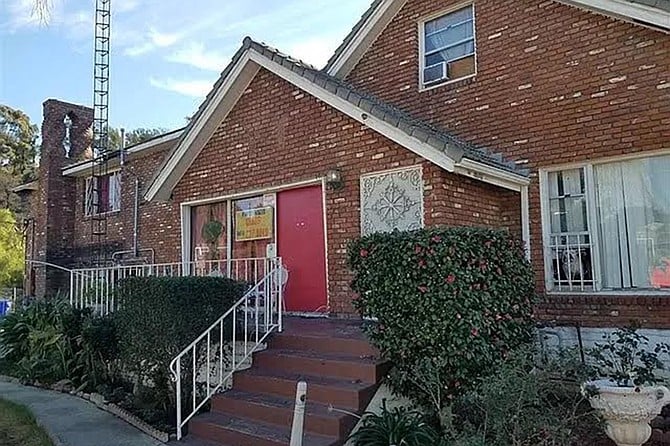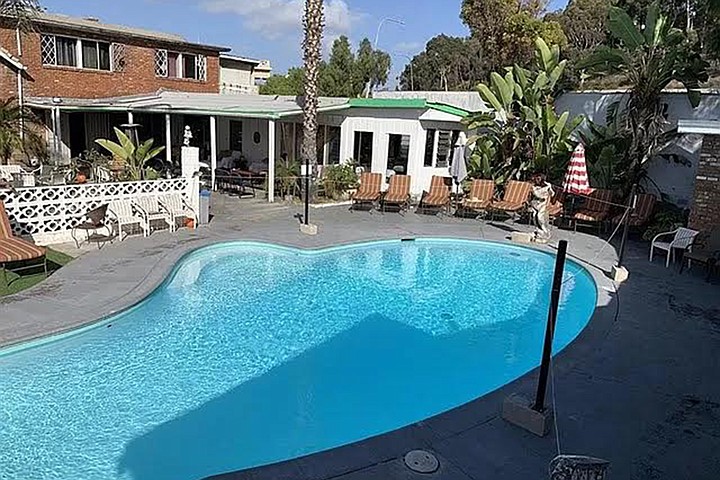 Facebook
Facebook
 X
X
 Instagram
Instagram
 TikTok
TikTok
 Youtube
Youtube

Stockton, a Southeast San Diego neighborhood wedged in among Logan Heights, Mt. Hope, and Grant Hill, isn’t the first place one thinks of when imagining million-dollar homes. With a median home value more than $300,000 below that of the typical San Diego community — never mind the Unreal mainstays of La Jolla, Rancho Santa Fe, and Del Mar — it probably doesn’t crack the top 10, or even 25, for locals who can name that many enclaves.
Heck, there aren’t even that many houses along east E Street. Most of the land here, bounded by the 94 and 15 freeways to the north and east respectively, is given over to industrial uses, contractor yards, or simply barren dirt lots razed of all structures.
But this hasn’t always been the case, or at least it certainly wasn’t in 1950, when boxing great and SoCal transplant Archie Moore chose to make San Diego his home. Active from 1935 through 1963 and one of the only pugilists to sustain a career spanning four decades, Moore sparred to a record of 186-23-10 and is still regarded as one of the best light-heavyweights of all time. Moving up to a true heavyweight later in his career, Moore sparred with (and was defeated by) both Rocky Marciano and a young Muhammad Ali, the latter of whom would be among legends such as George Foreman whom Moore trained at one point in his career.

After a rough-and-tumble childhood in St. Louis, Moore eventually landed in San Diego and became a local legend, not only for his punching prowess, but also for his community involvement, teaching the 20th-century’s preferred combat sport to underprivileged youth through his Any Boy Can organization.
Of course, Moore’s fame (he was also known for a handful of film and television roles, most notably his portrayal of Jim in 1960’s Adventures of Huckleberry Finn) demanded a house befitting his reputation. Finally, we come to this week’s house.
Built in either 1935 or 1950 (depending on whether you believe the listing retrieved from Zillow or the tax rolls), Moore’s former home at 3517 E Street boasts a majestic red brick exterior that contrasts sharply with the muted stucco finishes adorning most California residences. With over 5100 square feet of living space, it was and still is considerably larger than other contemporary homes, particularly for a neighborhood where the average monthly rent just barely tops $1100 in a city where $2000-plus is almost a given housing cost.
As a signature touch, Moore had a custom swimming pool dug in the shape of a boxing glove that easily stands out on Google Earth to this day. However, it seems the striking brick façade, with an ornate chimney cutout and custom iron work near the entryway, are about all that remind us of the home’s former grandeur.
“Great potential considering the surrounding land use,” is how listing materials for the property describe its current state. The dead-end location abutting two freeways promises “minimal or no traffic,” while there is “ample pool room toward the back of the property.... Buy a piece of history.
Some of the first photos we see are of the exterior. There’s the signature pool, along with a purple-lined above ground spa that has, for one reason or another, been drained. At least there’s plenty of seating, from picnic tables to a fire pit to a few couches draped in white fabric.
Moving inside, we encounter a wood-paneled parlor with a pool table sporting burgundy felt to match the 1970s-casino vibe carpet and a couple of similar vintage vinyl-wrapped diner booths. A green couch is draped in a white sheet.
Futher on, a living room. There’s a nice brick fireplace flanked by floor-to-ceiling mirrors on one side and what appear to be more sheet-wrapped couches (along with another gigantic mirror) on the other. The floor is painted a muted black, except in the area where traffic has worn the paint away.
The kitchen, comparatively spartan compared to the typical Unreal entry, at least sports solid stone countertops and a commercial-grade built-in refrigerator.
One of the only other interior shots we get to see is what appears to be a bedroom, devoid of furnishings like nightstands and dressers, but packed with plenty of beds and sofas, all again draped in white. Another giant mirror adorns one wall.
A web search of the estate’s address leads to a business located there called Thad’s, billed as the city’s “premier private social club” and one of “San Diego’s best kept secrets since 1974.”
Further elaboration can be found in a mixed bag of Yelp reviews regarding the parties hosted at Thad’s several times a week up until the pandemic shut things down. Some praise the “men must be fully nude to attend” policy, while others bemoan the decaying state of décor and the loose fit of the sheets covering most of the upholstered surfaces. At least we’ve got an idea now why they’re there.
In any case, public records tie Moore’s former mansion to a Leslie Young of Kentucky, though the property has changed hands several times since leaving the Moore family in 2002 without ever being publicly offered for sale.
The E Street abode was first listed for sale in November of 2019, it’s been in and out of escrow a couple of times since then, but the asking price of $1.6 million has remained unchanged. The operators of Thad’s would like to continue their lease once it’s sold.


Stockton, a Southeast San Diego neighborhood wedged in among Logan Heights, Mt. Hope, and Grant Hill, isn’t the first place one thinks of when imagining million-dollar homes. With a median home value more than $300,000 below that of the typical San Diego community — never mind the Unreal mainstays of La Jolla, Rancho Santa Fe, and Del Mar — it probably doesn’t crack the top 10, or even 25, for locals who can name that many enclaves.
Heck, there aren’t even that many houses along east E Street. Most of the land here, bounded by the 94 and 15 freeways to the north and east respectively, is given over to industrial uses, contractor yards, or simply barren dirt lots razed of all structures.
But this hasn’t always been the case, or at least it certainly wasn’t in 1950, when boxing great and SoCal transplant Archie Moore chose to make San Diego his home. Active from 1935 through 1963 and one of the only pugilists to sustain a career spanning four decades, Moore sparred to a record of 186-23-10 and is still regarded as one of the best light-heavyweights of all time. Moving up to a true heavyweight later in his career, Moore sparred with (and was defeated by) both Rocky Marciano and a young Muhammad Ali, the latter of whom would be among legends such as George Foreman whom Moore trained at one point in his career.

After a rough-and-tumble childhood in St. Louis, Moore eventually landed in San Diego and became a local legend, not only for his punching prowess, but also for his community involvement, teaching the 20th-century’s preferred combat sport to underprivileged youth through his Any Boy Can organization.
Of course, Moore’s fame (he was also known for a handful of film and television roles, most notably his portrayal of Jim in 1960’s Adventures of Huckleberry Finn) demanded a house befitting his reputation. Finally, we come to this week’s house.
Built in either 1935 or 1950 (depending on whether you believe the listing retrieved from Zillow or the tax rolls), Moore’s former home at 3517 E Street boasts a majestic red brick exterior that contrasts sharply with the muted stucco finishes adorning most California residences. With over 5100 square feet of living space, it was and still is considerably larger than other contemporary homes, particularly for a neighborhood where the average monthly rent just barely tops $1100 in a city where $2000-plus is almost a given housing cost.
As a signature touch, Moore had a custom swimming pool dug in the shape of a boxing glove that easily stands out on Google Earth to this day. However, it seems the striking brick façade, with an ornate chimney cutout and custom iron work near the entryway, are about all that remind us of the home’s former grandeur.
“Great potential considering the surrounding land use,” is how listing materials for the property describe its current state. The dead-end location abutting two freeways promises “minimal or no traffic,” while there is “ample pool room toward the back of the property.... Buy a piece of history.
Some of the first photos we see are of the exterior. There’s the signature pool, along with a purple-lined above ground spa that has, for one reason or another, been drained. At least there’s plenty of seating, from picnic tables to a fire pit to a few couches draped in white fabric.
Moving inside, we encounter a wood-paneled parlor with a pool table sporting burgundy felt to match the 1970s-casino vibe carpet and a couple of similar vintage vinyl-wrapped diner booths. A green couch is draped in a white sheet.
Futher on, a living room. There’s a nice brick fireplace flanked by floor-to-ceiling mirrors on one side and what appear to be more sheet-wrapped couches (along with another gigantic mirror) on the other. The floor is painted a muted black, except in the area where traffic has worn the paint away.
The kitchen, comparatively spartan compared to the typical Unreal entry, at least sports solid stone countertops and a commercial-grade built-in refrigerator.
One of the only other interior shots we get to see is what appears to be a bedroom, devoid of furnishings like nightstands and dressers, but packed with plenty of beds and sofas, all again draped in white. Another giant mirror adorns one wall.
A web search of the estate’s address leads to a business located there called Thad’s, billed as the city’s “premier private social club” and one of “San Diego’s best kept secrets since 1974.”
Further elaboration can be found in a mixed bag of Yelp reviews regarding the parties hosted at Thad’s several times a week up until the pandemic shut things down. Some praise the “men must be fully nude to attend” policy, while others bemoan the decaying state of décor and the loose fit of the sheets covering most of the upholstered surfaces. At least we’ve got an idea now why they’re there.
In any case, public records tie Moore’s former mansion to a Leslie Young of Kentucky, though the property has changed hands several times since leaving the Moore family in 2002 without ever being publicly offered for sale.
The E Street abode was first listed for sale in November of 2019, it’s been in and out of escrow a couple of times since then, but the asking price of $1.6 million has remained unchanged. The operators of Thad’s would like to continue their lease once it’s sold.